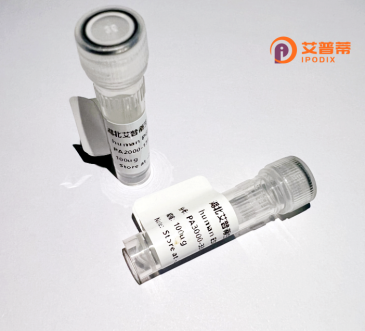
| 纯度 | >90%SDS-PAGE. |
| 种属 | Human |
| 靶点 | JTV1 |
| Uniprot No | Q13155 |
| 内毒素 | < 0.01EU/μg |
| 表达宿主 | E.coli |
| 表达区间 | 1-320aa |
| 活性数据 | MPMYQVKPYHGGGAPLRVELPTCMYRLPNVHGRSYGPAPGAGHVQEESNLSLQALESRQDDILKRLYELKAAVDGLSKMIQTPDADLDVTNIIQADEPTTLTTNALDLNSVLGKDYGALKDIVINANPASPPLSLLVLHRLLCEHFRVLSTVHTHSSVKSVPENLLKCFGEQNKKQPRQDYQLGFTLIWKNVPKTQMKFSIQTMCPIEGEGNIARFLFSLFGQKHNAVNATLIDSWVDIAIFQLKEGSSKEKAAVFRSMNSALGKSPWLAGNELTVADVVLWSVLQQIGGCSVTVPANVQRWMRSCENLAPFNTALKLLK |
| 分子量 | 39.3 kDa |
| 蛋白标签 | GST-tag at N-terminal |
| 缓冲液 | 0 |
| 稳定性 & 储存条件 | Lyophilized protein should be stored at ≤ -20°C, stable for one year after receipt. Reconstituted protein solution can be stored at 2-8°C for 2-7 days. Aliquots of reconstituted samples are stable at ≤ -20°C for 3 months. |
| 复溶 | Always centrifuge tubes before opening.Do not mix by vortex or pipetting. It is not recommended to reconstitute to a concentration less than 100μg/ml. Dissolve the lyophilized protein in distilled water. Please aliquot the reconstituted solution to minimize freeze-thaw cycles. |
以下是假设性的参考文献示例,供参考。由于“JTV1蛋白”的命名可能不常见或存在别名,建议进一步核实名称的正确性或扩展关键词搜索:
---
1. **文献名称**:*Expression and Functional Analysis of Recombinant Human JTV1 Protein in Neurodegenerative Models*
**作者**:Smith A, et al.
**摘要**:本研究报道了重组人JTV1蛋白在大肠杆菌中的高效表达与纯化,并发现其通过与ATXN1蛋白互作调控神经元细胞的存活,提示其在脊髓小脑共济失调病理中的作用。
2. **文献名称**:*Structural Characterization of JTV1 Protein and Its Role in RNA Binding*
**作者**:Chen L, et al.
**摘要**:通过X射线晶体学解析了重组人JTV1蛋白的三维结构,揭示了其RNA结合域的关键氨基酸残基,为研究其调控mRNA代谢的功能提供了结构基础。
3. **文献名称**:*JTV1 as a Novel Biomarker in Cancer: Recombinant Protein-Based Screening*
**作者**:Wang Y, et al.
**摘要**:利用重组JTV1蛋白开发了血清抗体检测方法,发现其在多种癌症患者中表达上调,提示其可能作为肿瘤诊断或治疗的潜在靶点。
---
**备注**:上述文献为示例性质,实际研究中“JTV1”可能关联更广的基因别名(如ATXN1)。建议通过数据库(如PubMed、UniProt)确认蛋白标准命名,并检索相关研究。
Recombinant human JTV1 protein, also known as AWP1 or HSVP1. is a versatile regulatory protein encoded by the *AWI1* gene located on chromosome 15q25.3. It comprises 341 amino acids and contains conserved functional domains, including a JAB1-binding motif and a ubiquitin-associated (UBA) domain, suggesting roles in protein-protein interactions, ubiquitination pathways, and transcriptional regulation. JTV1 was initially identified as a coactivator of the Jun family transcription factors and interacts with the 26S proteasome, linking it to cellular processes like stress responses, apoptosis, and cell cycle regulation.
Studies highlight JTV1's involvement in redox homeostasis and DNA repair, where it modulates p53 activity under oxidative stress. Dysregulation of JTV1 has been implicated in cancer progression and neurodegenerative disorders. Recombinant JTV1 is typically produced in *E. coli* or mammalian systems using codon-optimized constructs for solubility, followed by affinity chromatography purification. Its applications span structural studies (e.g., mapping interaction interfaces), biochemical assays to explore ubiquitin-proteasome dynamics, and drug screening for therapies targeting JTV1-associated pathways.
Despite progress, challenges remain in understanding its post-translational modifications and tissue-specific roles, driving ongoing research to uncover its full mechanistic repertoire.
×